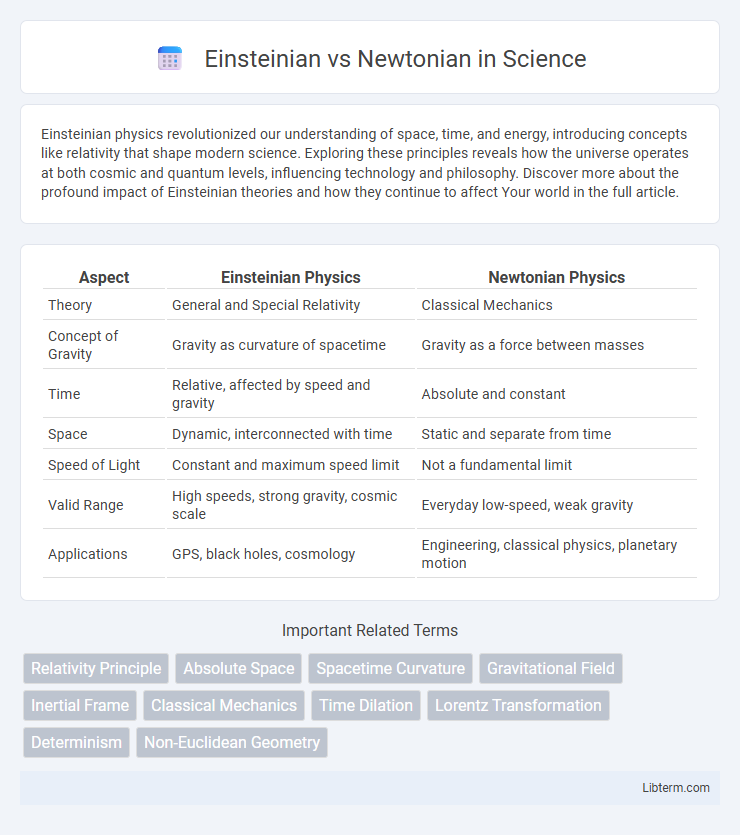Einsteinian physics revolutionized our understanding of space, time, and energy, introducing concepts like relativity that shape modern science. Exploring these principles reveals how the universe operates at both cosmic and quantum levels, influencing technology and philosophy. Discover more about the profound impact of Einsteinian theories and how they continue to affect Your world in the full article.
Table of Comparison
| Aspect | Einsteinian Physics | Newtonian Physics |
|---|---|---|
| Theory | General and Special Relativity | Classical Mechanics |
| Concept of Gravity | Gravity as curvature of spacetime | Gravity as a force between masses |
| Time | Relative, affected by speed and gravity | Absolute and constant |
| Space | Dynamic, interconnected with time | Static and separate from time |
| Speed of Light | Constant and maximum speed limit | Not a fundamental limit |
| Valid Range | High speeds, strong gravity, cosmic scale | Everyday low-speed, weak gravity |
| Applications | GPS, black holes, cosmology | Engineering, classical physics, planetary motion |
Introduction to Einsteinian and Newtonian Physics
Newtonian physics, based on Isaac Newton's laws of motion and universal gravitation, describes the classical mechanics of everyday objects and provides accurate predictions for most macroscopic phenomena. Einsteinian physics, introduced by Albert Einstein, revolutionizes our understanding of space, time, and gravity through the theories of special and general relativity, explaining phenomena at high velocities and strong gravitational fields. This paradigm shift highlights the limitations of Newtonian mechanics and extends physics to the realm of high-speed and cosmological events.
Fundamental Differences in Approach
Einsteinian physics redefines gravity as the curvature of spacetime caused by mass and energy, while Newtonian physics describes gravity as a force acting at a distance between two objects. Newtonian mechanics assumes absolute time and space, providing accurate predictions at everyday scales, whereas Einsteinian relativity incorporates the relative nature of time and space, essential for explaining phenomena at high velocities and strong gravitational fields. This fundamental difference in conceptualizing gravity and spacetime leads to distinct mathematical frameworks and experimental predictions in both theories.
Newtonian Mechanics: Core Principles
Newtonian mechanics is based on three fundamental laws of motion that describe the relationship between a body and the forces acting upon it, forming the foundation for classical mechanics. The first law states that an object remains at rest or in uniform motion unless acted upon by an external force, emphasizing inertia. Newton's second law quantifies this relationship with the equation F = ma, where force equals mass times acceleration, while the third law asserts that every action has an equal and opposite reaction.
Einsteinian Relativity: Key Concepts
Einsteinian relativity, encompassing special and general relativity, revolutionizes our understanding of space, time, and gravity beyond Newtonian mechanics. Special relativity introduces the constancy of the speed of light and time dilation effects at high velocities, while general relativity describes gravity as the curvature of spacetime caused by mass and energy. These concepts fundamentally alter predictions about motion, gravitational fields, and the behavior of objects near massive bodies or high speeds.
Space and Time: Contrasting Perspectives
Einsteinian physics redefines space and time as a unified four-dimensional continuum called spacetime, where gravity results from the curvature caused by mass and energy. Newtonian physics treats space and time as absolute, separate entities with space as a fixed stage and time flowing uniformly everywhere. This fundamental difference underpins modern cosmology and GPS technology, as Einstein's relativity provides accurate predictions that Newtonian mechanics cannot achieve under extreme conditions.
Gravity: Forces vs. Spacetime Curvature
Newtonian gravity describes gravitational attraction as a force between masses acting at a distance, following an inverse-square law formulated by Isaac Newton. Einsteinian gravity, based on General Relativity, interprets gravity not as a force but as the curvature of spacetime caused by mass and energy, influencing the motion of objects along geodesics. This shift from force to geometry allows Einstein's theory to accurately explain phenomena such as gravitational time dilation, light bending, and the orbit of Mercury, where Newtonian predictions fail.
Experimental Evidence and Observations
Einsteinian physics revolutionized our understanding through experimental evidence such as the 1919 Eddington expedition, which confirmed light bending around the sun, validating general relativity over Newtonian predictions. While Newtonian mechanics accurately describe everyday motions, precise observations like gravitational time dilation measured by atomic clocks and the perihelion precession of Mercury's orbit highlight discrepancies resolved only by Einstein's theories. Experimental confirmations from modern technologies, including GPS systems relying on relativistic corrections, further emphasize the superior observational alignment of Einsteinian physics with reality.
Limitations of Newtonian Physics
Newtonian physics accurately describes motion and forces at everyday speeds and scales but fails under extreme conditions such as near light speed or strong gravitational fields. It cannot account for phenomena like time dilation, length contraction, or the curvature of spacetime, which are explained by Einsteinian relativity. These limitations highlight the necessity of Einstein's theories for understanding cosmological and quantum-scale events.
Modern Applications of Einsteinian Theory
Einsteinian theory, particularly general relativity, underpins modern technologies such as GPS, where precise time dilation corrections are crucial for accurate positioning. Unlike Newtonian mechanics, which suffices for everyday-scale calculations, Einsteinian physics governs high-speed and strong gravitational fields, influencing advancements in astrophysics and cosmology. Innovations in quantum mechanics and gravitational wave detection also rely heavily on Einstein's principles to expand our understanding of the universe.
The Future of Physics: Beyond Einstein and Newton
Exploring the future of physics involves moving beyond the classical frameworks of Newtonian mechanics and Einsteinian relativity to embrace quantum gravity and string theory, aiming to unify general relativity with quantum mechanics. Research in dark energy and dark matter challenges existing paradigms, prompting new models that transcend Einstein's spacetime curvature and Newton's laws of motion. Advanced particle accelerators and cosmological observations will drive breakthroughs, reshaping our understanding of the universe's fundamental forces and the nature of reality.
Einsteinian Infographic

 libterm.com
libterm.com